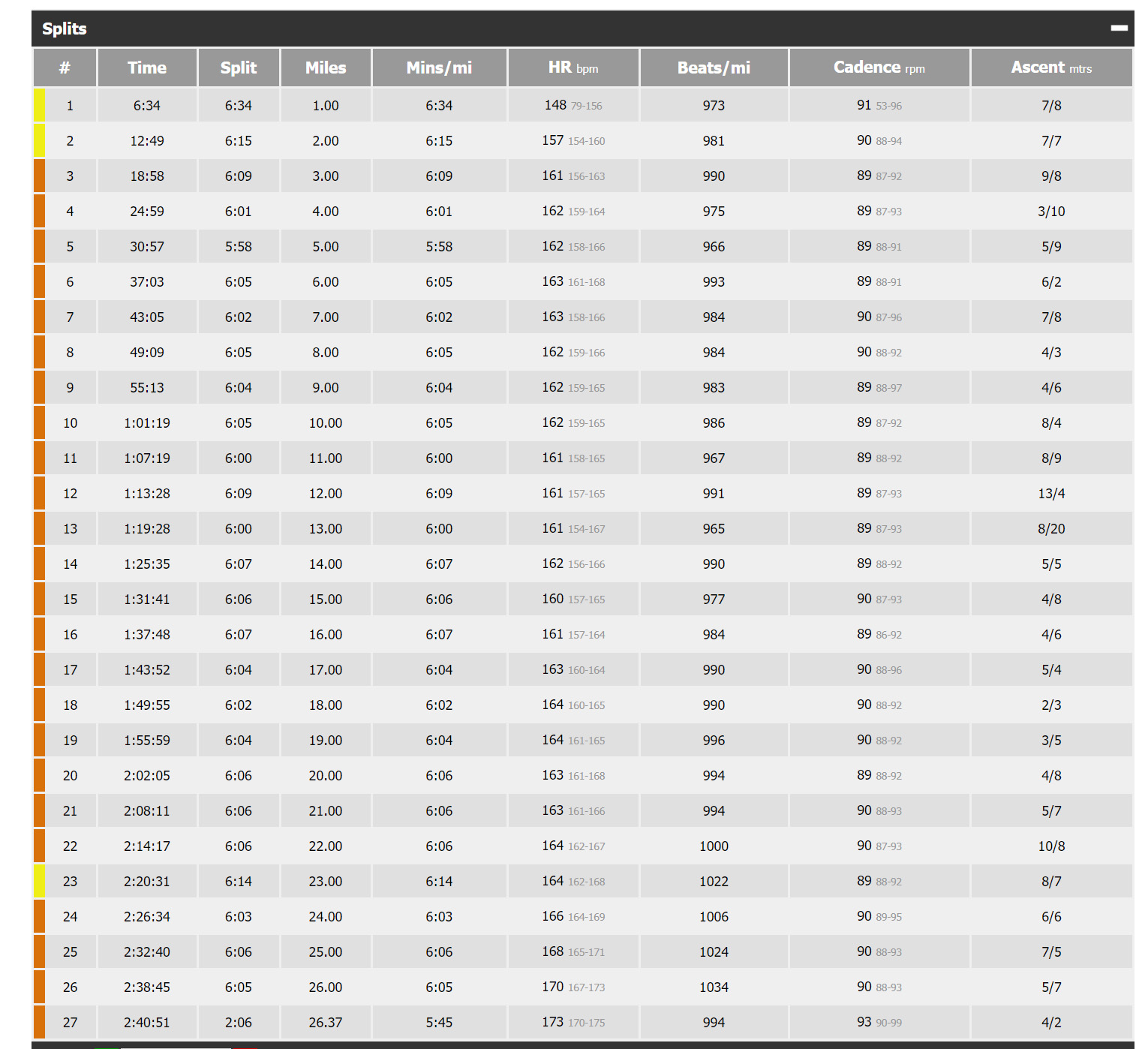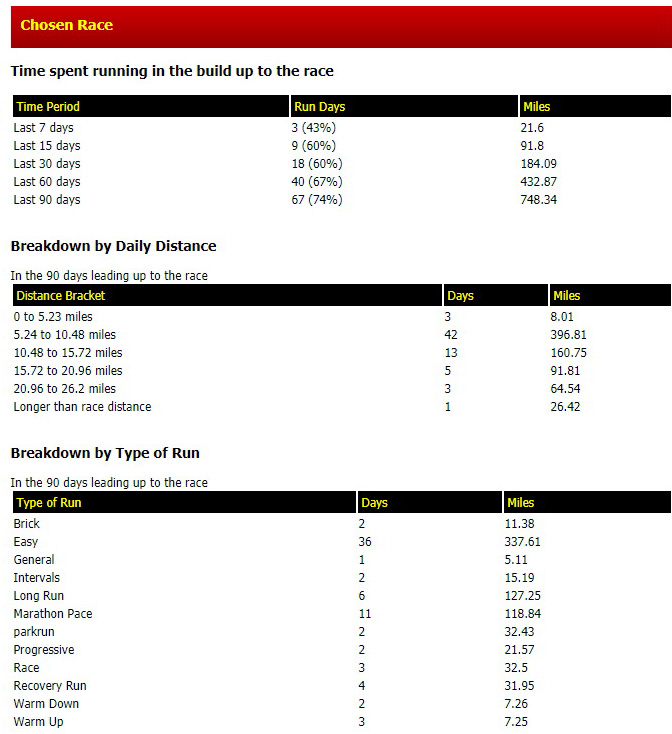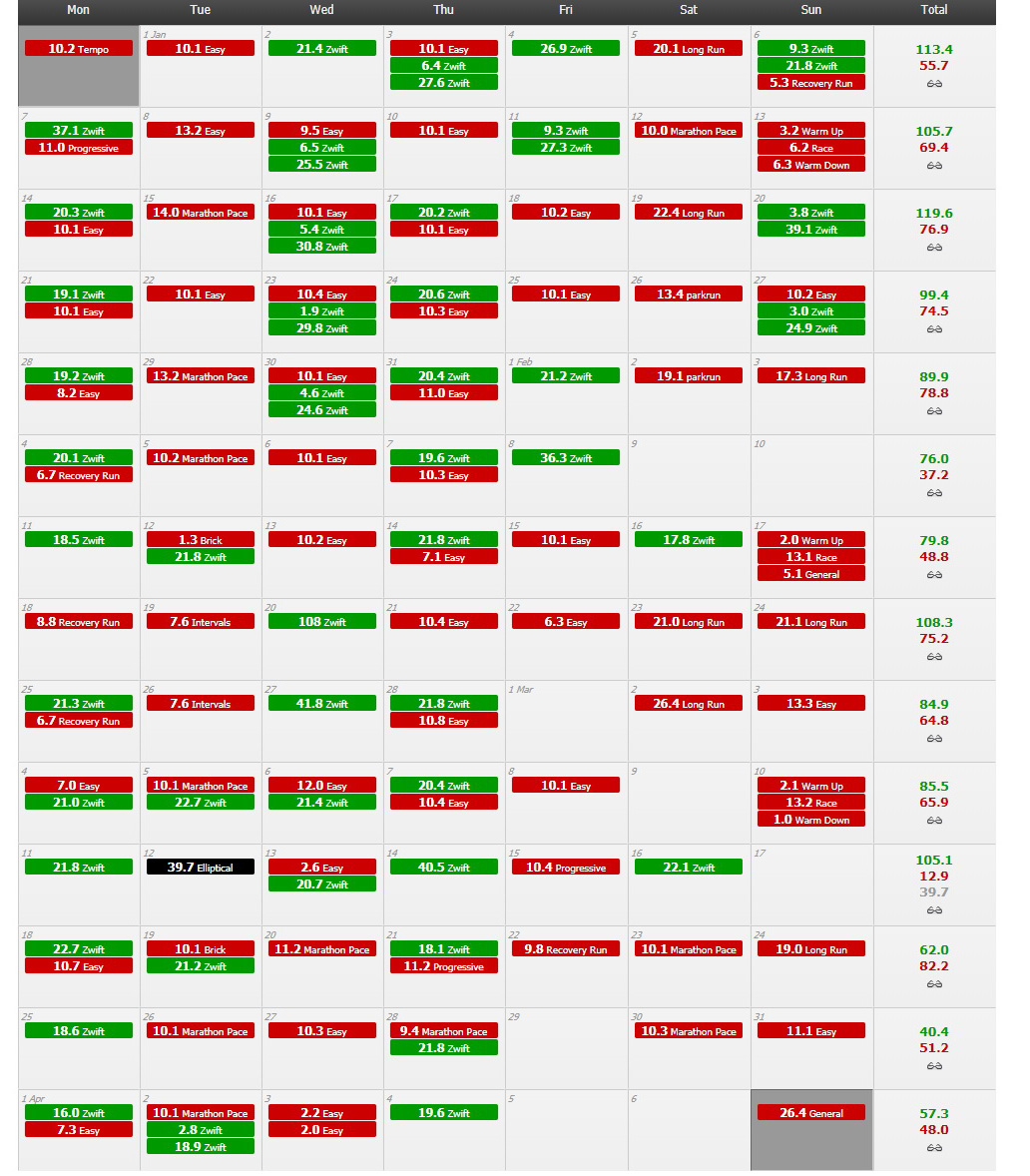Prerace
Despite Manchester from Grantham being comparable distance to Grantham to London I’d decided fairly early that I wasn’t going to travel on the morning of the race to Manchester from home. I balked at the idea of paying large amounts of money for a hotel room so opted, for the first time, to use the family caravan to stay close to the race and then stay up in the Manchester area with the family for a few days as the race was taking place during the Easter holidays.
We were staying at a Caravan and Motorhome Club site in Bury, which is in the outskirts of the Greater Manchester district and, crucially, on the tram network that I planned to use to get to and from the race. We left for Bury on the Saturday morning and was immediately grateful for Richard at Grantham Leisure Ltd who was able to immediately identify a terrible sounding (but actually relatively harmless) issue with our tow bar that hit us when setting off on our journey that was remedied with some sand paper and brake cleaner that he very kindly let us keep at no cost.
That drama out of the way the journey to Bury was straightforward enough. The site was pleasant enough, set in Burrs Country Park with constant reminders of the area’s industrial past, including a steam train running on a line just behind our caravan, which bought great boyish pleasure! Once set up and lunch eaten most of the afternoon was spent relaxing as much as possible.

My pre marathon meal of choice is pizza, which isn’t so easy to cook in the caravan so was relying on takeaway. After googling for Bury’s finest pizza establishments I settled on my first ever Domino’s Pizza. I was impressed with the app and collection procedure; less impressed with the actual quality of the pizza and that they are still texting me six months later in the feint hope I may actually use Domino’s Bury while living in Grantham. I washed the pizza down with a small glass of white wine – the habits of caravan lifestyle proved too hard to resist.
The rest of the evening was spent playing the usual parlour games we play with the kids in the caravan before heading to bed at around 10pm. The beauty of staying in the caravan was that, so long as the weather was not biblically bad, I was almost assured a good night’s sleep in a familiar bed – something that I rarely get when staying in a hotel room.
I woke at around 5am and let the legs slowly come to life as I made the short walk to the site’s washroom facilities. I was sure I’d be the only one who’d hatched the same accommodation plan for Manchester but there were at least two or three others who clearly had the same intentions. After a breakfast of 5 small cereal bars washed down with a large mug of black coffee I got the wife to drive me the couple of miles or so to the main tram stop in Bury. The plan was for her to return back to the caravan for a bit before getting a later tram with the kids to watch the race at various points alongthe course.
Again for some reason I was sure that I would be the only one racing at Manchester who would consider getting a tram from Bury but as it turned out there were already many runners on the platform waiting for the first tram to depart at around 7am. They were mostly from local clubs, mostly far too enthusiastic for six something in the morning, but at least the platforms were not as busy as they are when trying to get to the start of London at Blackheath.
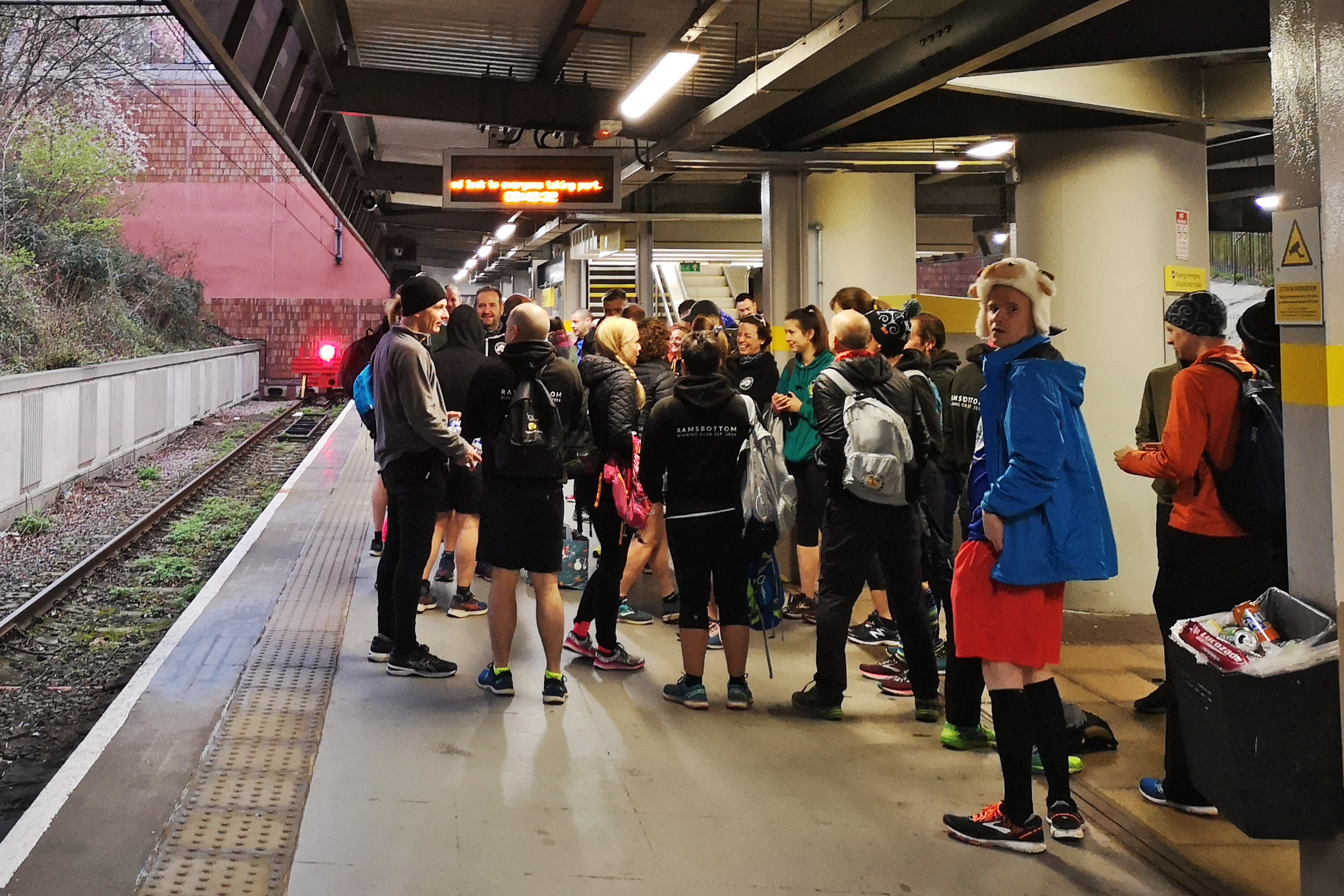
The tram journey took around 45 minutes, including a change in the heart of Manchester when I met Jack Dodwell of GRC, who was racing, and his father, who had driven them from Grantham that morning. Once off the second tram it was a few minute’s walk before we came to the boulevard of Portaloos where I stumbled upon quite a few of the other GRC contingency who were taking part in the race. It was then on to drop off the bag at baggage near the finish line. By now the time was around 8:30 and not too long left before the 9am start. There was time for a quick photo with around half the GRC runners before I made my way to the start.
On one of the last unofficial toilet stops I happened to bump into Vince Riviere who I’d first met at the Leeds Abbey Dash. He’d gone on to have quite a winter with a string of great races including a brilliant low 2:37 at the Valencia Marathon. We wished each other well and I dreamed of whether it would be my day to break 2:40 for the first time. Working my way through the crowds of runners starting from slower pens, I finally got to the front pen with around ten minutes to spare. I found somewhere where you could lighten the load in relative privacy (albeit with a load of other runners doing the same thing) one last time before making my way to the start line. I looked up to the skies and blessed the weather gods for providing pretty much perfect conditions – cloudy skies, a light easterly breeze and temperatures maxing out at around 11C. I could conjour up plenty of excuses for a poor performance, the weather couldn’t be one of them!
The Race
As the final countdown began and the pre-race nerves around me became almost unbearable it was with great relief that the starting horn was sounded dead on time at 9am. Despite the large numbers running we were able to run unrestricted from the off and some around me clearly were going off way too fast, almost totally out of breath in the opening couple of minutes. Despite swathes of runners coming past me I stuck as closely as I could to the game plan of max 150 bpm for the opening mile, 155 bpm for mile two, 160 bpm for mile three and a maximum of 165 bpm to twenty miles.
This deliberately easy start meant I felt like I was chomping at the bit, which was potentially a good sign as sometimes the opening miles can feel quite laboured. The opening mile was 6:34 which I hoped would be by far the slowest mile of the race. Mile 2 was 6:15 and I went through mile 3 in 6:09, which coincided with the course completing its mini loop east before heading southwest towards Stretford, Sale and Altrincham before heading back to the start via Urmston.
The fourth mile was the first where I allowed myself the luxury of getting to 165 bpm and I was pleased to clock a 6:01, which was right at the top end of what I thought I might be able to hit after all the weeks of training at marathon heart rate. Better was to come in mile five when I ran a 5:58 (the fastest of the race) before I ran 6:05 for mile 6. Thereafter the splits to mile 20 were very consistent with only nine seconds covering the quickest (6:00 – mile 13) and the slowest (6:09 – mile 12). The difference in these two miles could be explained in that we climbed the biggest ‘hill’ of the race (no more than a bridge over a railway) in mile 12 at Altrincham and came down in mile 13.
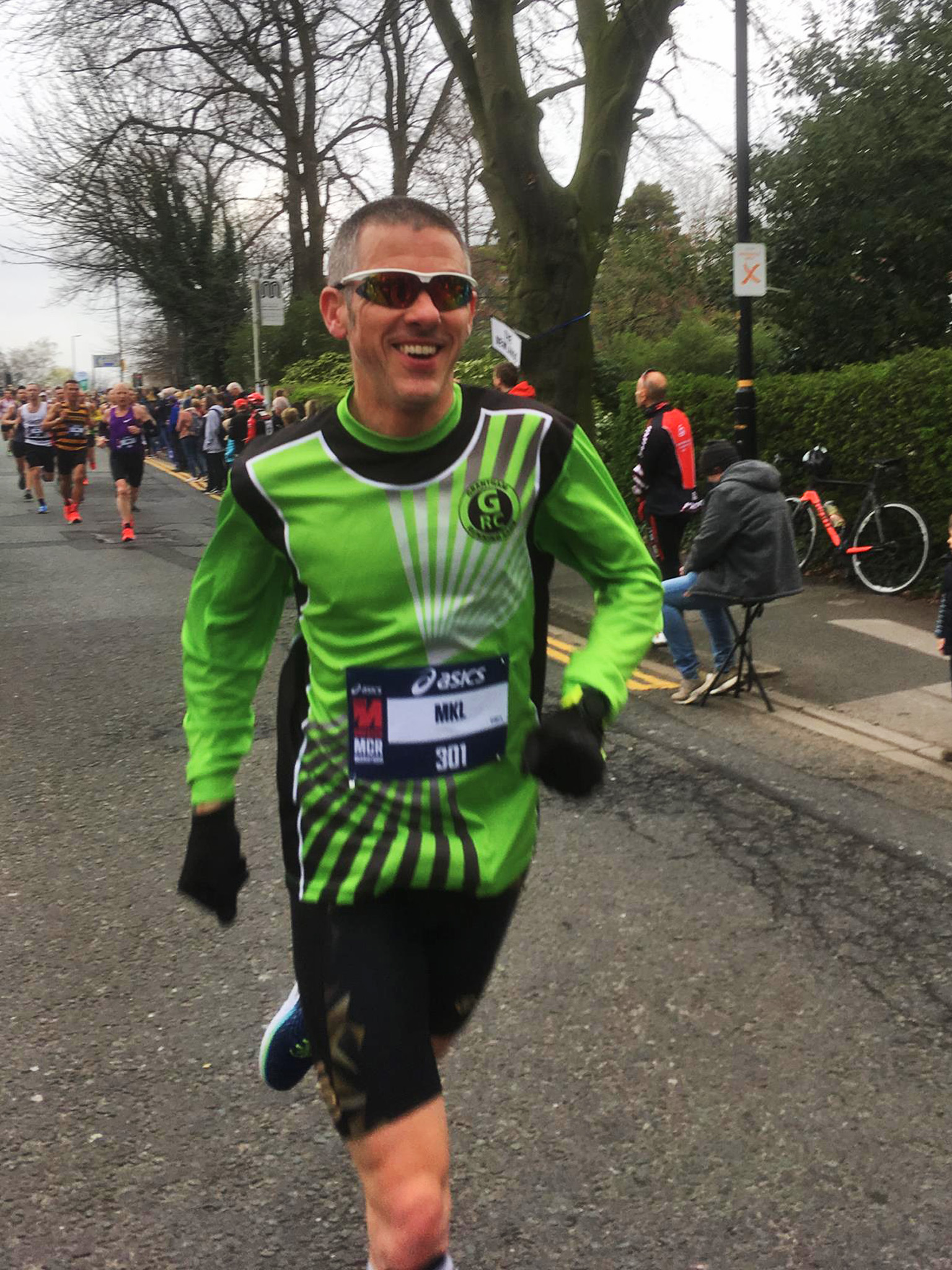
Picture c/o Dean Riggall.
Given the consistency of mile splits you may be forgiven for thinking it was plain sailing. Alas this was not the case. All was well until around that bridge at 12 miles. I’d already seen my family out once on the course at around eight miles and taken the first of three gels (SIS that I was using in a race for the first time). Without warning I felt a sharp pain in my left hamstring. At first I thought it was cramp but the pain disappeared as soon as it came. Anxious I wasn’t in the mood for high fiving the Altrincham football club mascot as I passed the family for the third and final time before the finish. Indeed the family were worried I might punch him as he generally got in runners’ way – I was very restrained under the circumstances!
I got through the convoluted Altrincham loop – complete with odd run through what looks like the back of a Boots car park without drama and was hoping that the pain in the hamstring was a one off as I passed through halfway in just outside eighty minutes. However at the next left turn where crowds were perhaps at there biggest, I felt a sharper, longer more sustained pain in my left hamstring. This forced me briefly to a slow jog and, assuming it was cramp, I was already wondering whether it would be a good time to consider dropping out of the race.
Mercifully almost as quick as the pain came on it disappeared entirely. This led me to make some quick assumptions that it wasn’t cramp, wasn’t a muscle pull or tear and was almost certainly some kind of sciatica similar to what had struck my calf muscle at the Retford Half Marathon. Considering I had slowed for a period mile 14 wasn’t nearly as disastrous as I feared clocking, 6:07. The mind has a neat way of blocking out painful episodes from the memory bank so I can’t recall how often I suffered a repeat of the sciatica pains, but I estimate I had a couple more in mile 15, then perhaps two or three more up to around mile 18. They must have been still troubling me at mile 17 as there was a photo of me uploaded to Facebook shouting at fellow GRC runner and spectator at the race due to injury Dean Riggall that I was suffering from Sciatica.
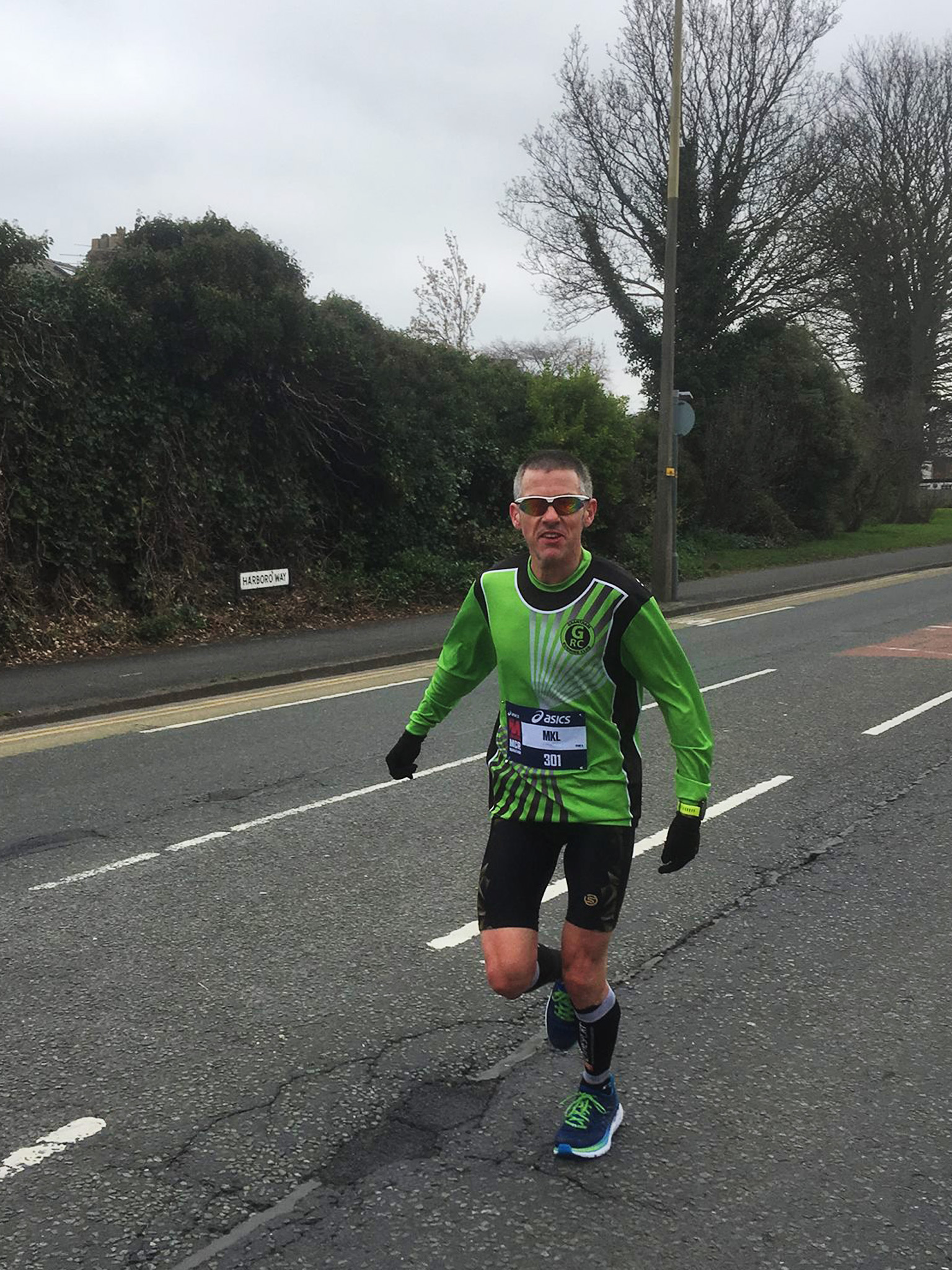
Picture c/o Dean Riggall.
The follow up bursts of discomfort weren’t as severe as the blast of pain that had forced me to slow, indeed they barely caused me to slow at all, they served more to not have me push on quite as much as I perhaps could have, the heart rate veering closer to 160 bpm than 165. One other precautionary tactic was that on all the remaining ninety degree corners, of which there were plenty on this course that uses a lot of residential streets, I made sure I took a very wide, cautious line through the corner, using plenty of road and trying not to force any sharp turns. This may have added a few extra meters per turn but I sensed it would perhaps help minimise any further distress to the leg.
By mile eighteen nearly four miles had passed since the bad pain and I was gaining a little more confidence that I was able to make it at least to the finish. The mile splits were still good, hovering just over six minutes a mile. It was around here I made an adjustment on my Garmin’s race pacer to allow for the distance creep that had built in compared to the official distance markers. The news was positive, I was on course to run just outside 2:40 – a PB was on the cards and if I could muster something special perhaps, just perhaps a sub 2:40 was possible.
The twenty mile marker is a key moment in any marathon, it’s where a race begins if you abide to the famous maxim a marathon is a twenty mile steady run with a 10K race at the end. It’s where at many marathons the crowds are at their deepest and most enthusiastic. At Manchester it coincides with where the race becomes, for a mile or two, its most rural and most sparse in terms of support. For some this is a bit of an issue, to be honest it doesn’t really bother me too much, I quite enjoyed being able to focus on the task in hand of getting to the finish as quick as possible.
Reasonably content that the dodgy leg wasn’t going to get any worse I guzzled down the third and final gel (A double espresso one, which I felt certainly gave a good buzz) and put the gas down at 20 miles as per the best case scenario race strategy. This simply meant I abandoned the 165 bpm max limit and attempted to run as at high a BPM as the body will allow me.
Most times I find this unattainable, today was one of those rare races where I was able to increase the HR to between 166-169 bpm. Having set an alert for the race on my Garmin to let me know when I had exceeded 165 BPM I had planned to switch this off fearing the nagging beep and buzz would get annoying. As it happened the opposite happened and I found the alert a reassurance that I was still able to push the effort.
Because the body was, by now, pretty fatigued the reality was that I wasn’t getting any quicker even with the extra BPM, but crucially I was able to more or less maintain the same pace I’d run the previous seventeen miles at. Three consecutive 6:06 miles saw me pass a lot of runners, many of whom were beginning to see the wheels well and truly fall off.
Mile 23 saw a little blip in the pace as it dropped to 6:14, but this mile contained a quite noticeable climb for part of the mile. Having had no repeat of the sciatica since around mile 18 I’d by now all but forgotten the injury and was giving it everything I could, concentrating on picking off runners and trying to keep my predicted finish time as quick as possible.
Mile 24 was pleasing at 6:03, with mile 25 much the same – another 6:06. The final mile is a bit marmite – some love the ability to see the finish line from nearly a mile away, I found it a bit annoying as it never seemed to get any closer. It became more annoying as I had a runner in front of me who saw fit to have a couple of his friends recording him from a bicycle that was sheltering him from the wind. As I passed him his friends urged him to stick to me and kick past at the finish. This made me doubly determined to ensure it didn’t happen!
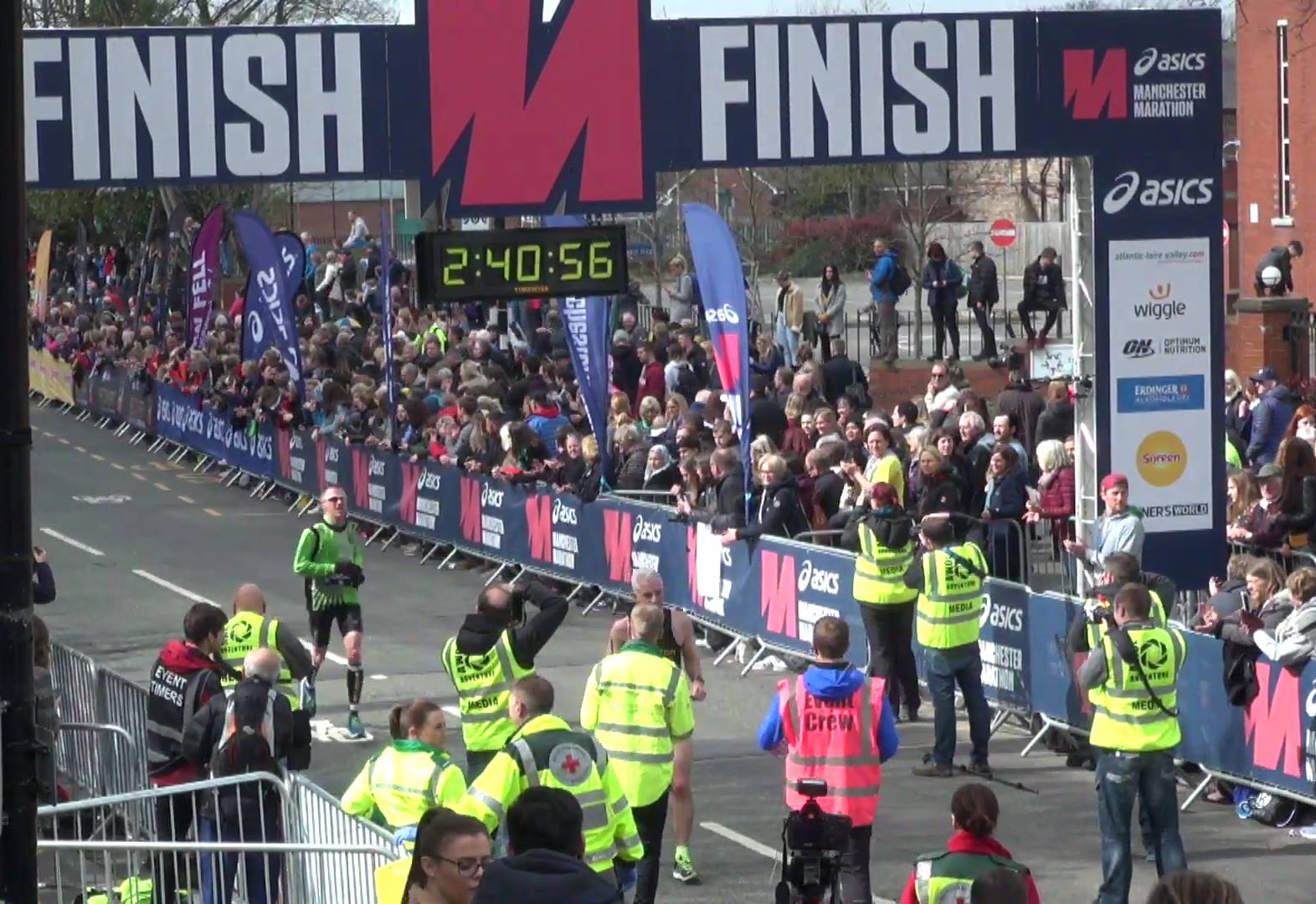
More annoying still was a giant screen that showed the finish line that from a distance looked just like it was the finish until you realised there was another slight right turn and around a third of a mile to the finish. This produced a protracted and painful attempt at a sprint finish as I made my way to the finish line. I crossed the line tired, but happy in 2:40:47.
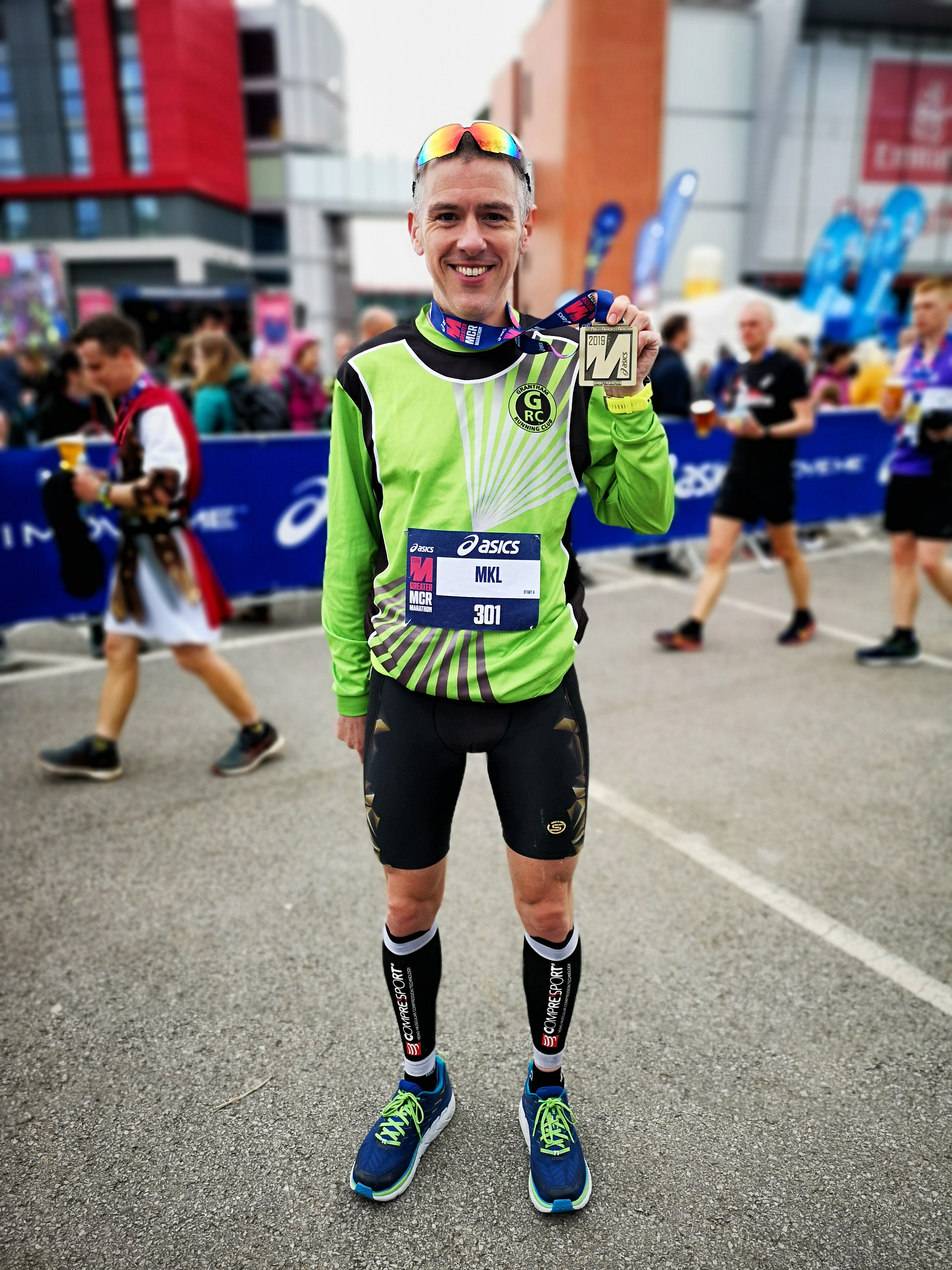
I was delighted to break my PB by nearly a minute and set a new club record; a little frustrated that without the sciatica issues there was every chance I could have broken that 2:40 barrier. I must have recovered quite quick as I was soon having a good old chat with the winner of the women’s race, who had set a big new PB. Then collecting my bag a few minutes later I bumped in again with Vince, who had clocked another sub 2:40 time despite suffering a fall and inflicting damage to his Vaporfly 4%s. I looked longingly at his shoes wondering what I may have achieved if I were wearing those rather than my tried and trusted Hoka Cliftons….
With the race done, medal collected, and repatriated with the family, it was just a case of getting the tram back to the Caravan site, treating it as a badge of honour of sorts that I was at the station at the same time as Steve Way, who had collected a considerable number of fans asking his opinion of the race.
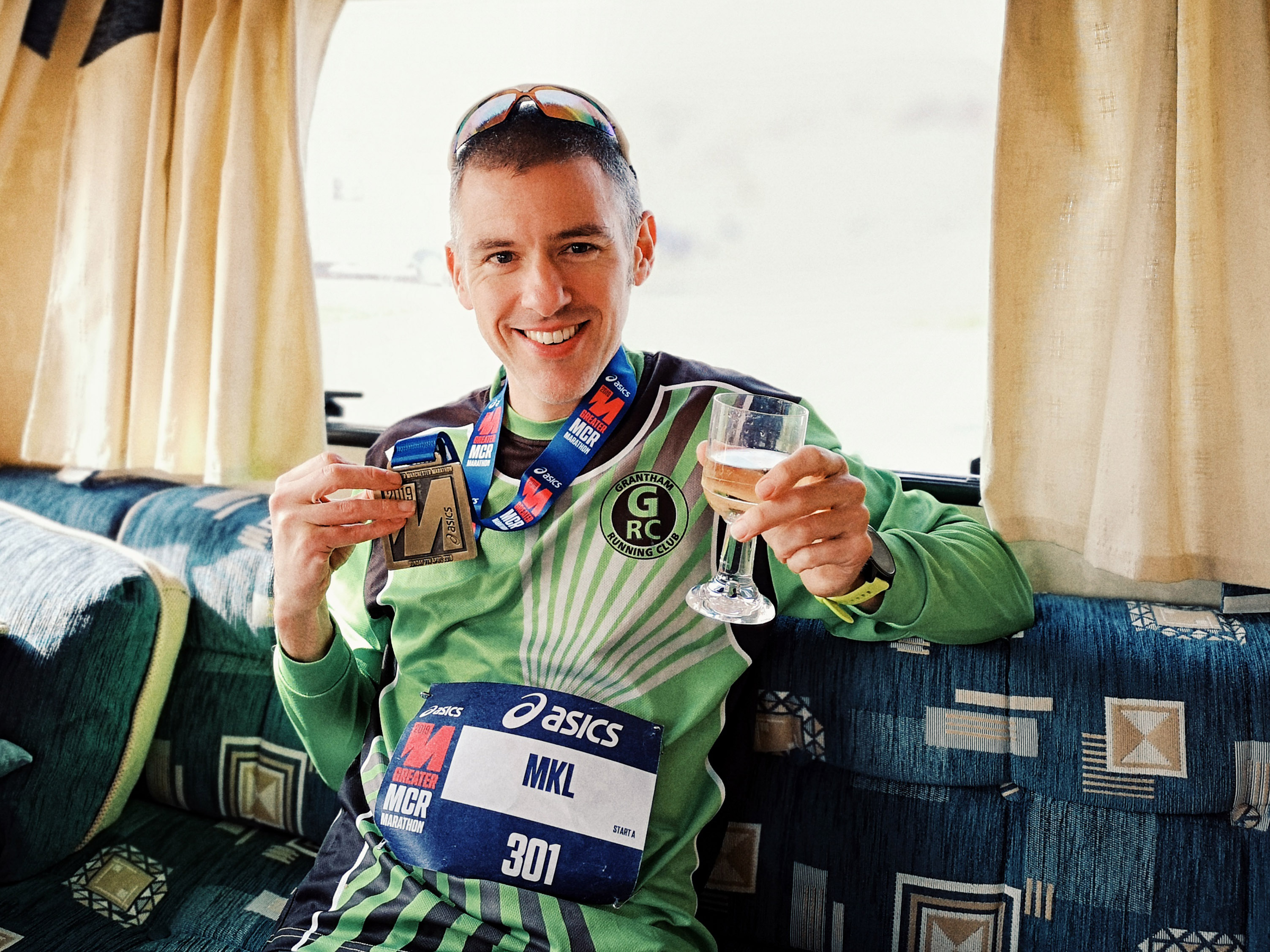
Once back at the Caravan I wasted no time in fulfilling a promise I’d declared on Facebook that I would be back cooking chicken on the barbecue and drinking sparkling wine by 2pm. By 10pm and some drinks later and plenty of hours sitting in a caravan, the hamstring sciatica had turned into a full on case of a locked hip so painful that I almost had to ask to be picked up in the car when I couldn’t get back from the toilet block to the caravan!
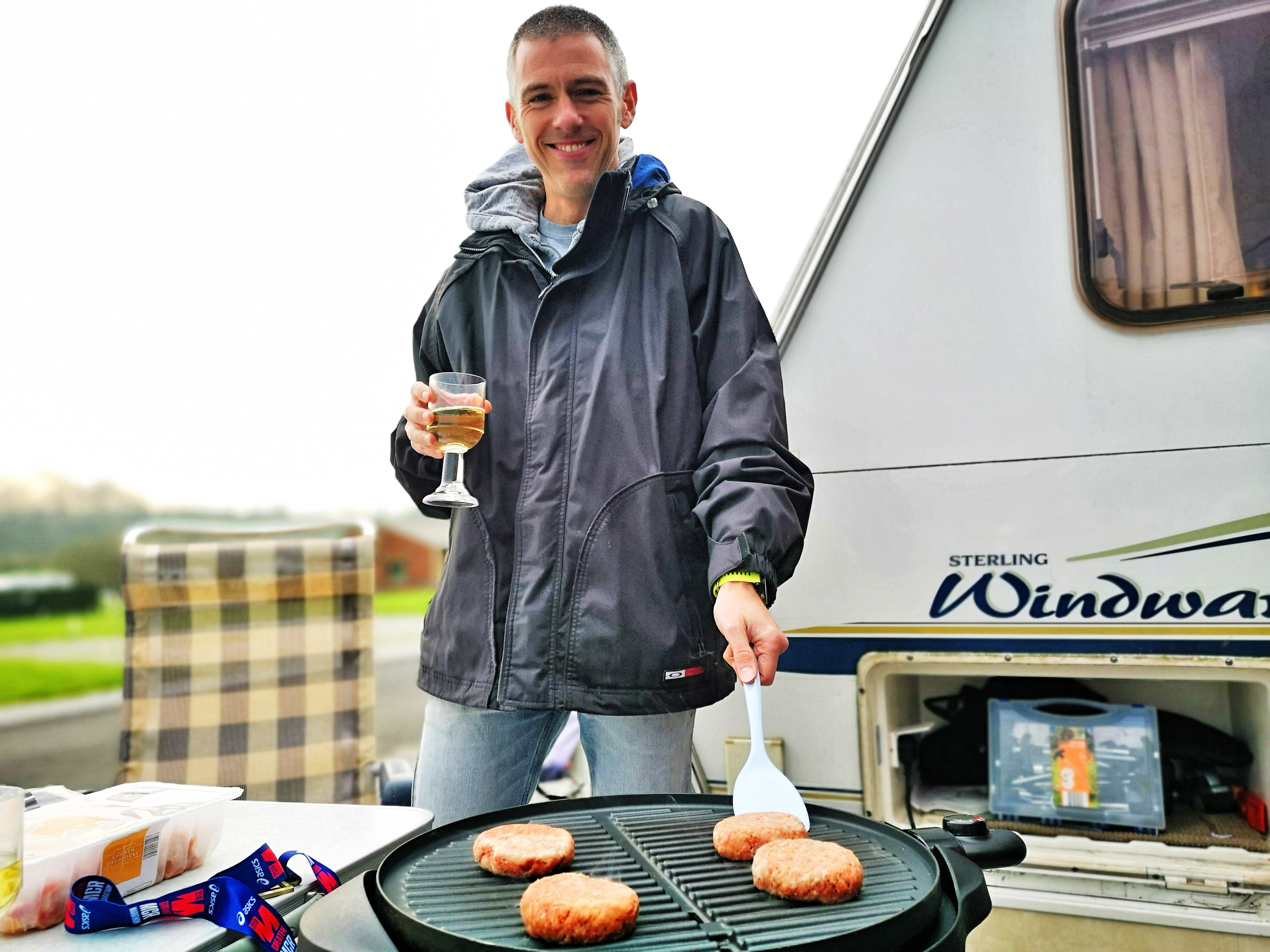
The next couple of days were spent recovering and enjoying Manchester. I managed a fairly short exploratory run on the Wednesday morning before heading back home – seemingly with no lasting damage done to the left leg.
Having run it twice now (Once in the infamous short course days) I would certainly recommend Manchester as a great alternative marathon to London – it’s flatter, has less crowd support (Which is a perverse positive) and coming early in April is more likely to have cooler conditions. I enjoyed the pre-race caravan experience so much I have decided to do something similar if I take part in the 2020 London Marathon.

